2014 was an above-average year for books in my view. Quite a few terrific titles turned up from both established and debuting authors, with a few, I’m certain, that will go on to become classics, such as…
Standout Fiction
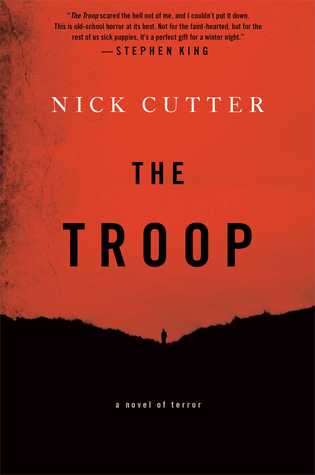 THE TROOP by NICK CUTTER (Gallery Books) is a downright ferocious exercise in no-frills fright, and my favorite horror novel of 2014. It concerns five 15-year-old boy scouts, whose ranks include the macho Kent, the nerdy Newt and the creepy Shelly, on a weekend camping trip in the Canadian wilderness, together with their middle-aged scoutmaster Tim. On their first night a shockingly emaciated man turns up who evinces an astounding appetite despite his gauntness. The man, it transpires, has been infected with a bioengineered parasitic worm that multiplies rapidly. You can be sure that contagion is a definite concern over the course of the ensuing weekend, as fear and desperation take hold of the troop and a toxic LORD OF THE FLIES-esque dynamic prevails.
THE TROOP by NICK CUTTER (Gallery Books) is a downright ferocious exercise in no-frills fright, and my favorite horror novel of 2014. It concerns five 15-year-old boy scouts, whose ranks include the macho Kent, the nerdy Newt and the creepy Shelly, on a weekend camping trip in the Canadian wilderness, together with their middle-aged scoutmaster Tim. On their first night a shockingly emaciated man turns up who evinces an astounding appetite despite his gauntness. The man, it transpires, has been infected with a bioengineered parasitic worm that multiplies rapidly. You can be sure that contagion is a definite concern over the course of the ensuing weekend, as fear and desperation take hold of the troop and a toxic LORD OF THE FLIES-esque dynamic prevails.
You may—okay, very likely will—be upset by this book, but I guarantee you’ll have a hard time putting it down. My one complaint (a minor one) is with the use of retrospective newspaper clippings and magazine interviews to fill out the narrative. While this device succeeds in imparting various explanatory tidbits in an economical manner, it also gives away several crucial details (such as the number of people who survive the weekend) too far in advance. But that annoyance aside, THE TROOP is a triumph in every respect, satisfying as both a creepy-crawly horror story and a profound glimpse into the heart of darkness.
CONSUMED is the debut novel by DAVID CRONENBERG (Scribner), who evinces a thoroughly unique 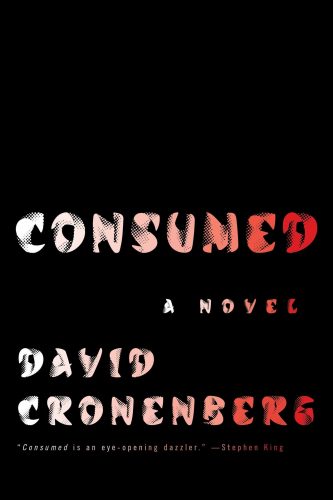 and individual fictional voice that falls somewhere between those of William Gibson and Don DeLillo in its concentration on technological minutiae and elegant perversity.
and individual fictional voice that falls somewhere between those of William Gibson and Don DeLillo in its concentration on technological minutiae and elegant perversity.
Set in a future world where do-it-yourself mastectomies and ambient hearing aids are in vogue, it follows Nathan and Naomi, a pair of workaholic journalists who share twin passions for technology and depravity. This relationship is conducted largely online, with Nathan and Naomi spending the majority of their time pursuing their respective obsessions. In Nathan’s case that obsession is with a renegade surgeon named Zoltan Molnar—and a venereal disease Nathan catches from one of Molnar’s patients—while Naomi is on the trail of Aristide Arosteguy, a Marxist philosopher accused of dismembering and cannibalizing his wife Celestine.
Arosteguy’s account, as elucidated in an extended first person monologue, is the book’s most overtly Cronenbergian element. This is to say that it’s the most gruesome bit, with Celestine claiming to have a hive of insects swarming in her left breast, and Arosteguy coming to share her delusions.
Unlike Cronenberg’s films, CONSUMED is quite expansive and overstuffed. The narrative is frequently diluted by lengthy ruminations on subjects ranging from post-menopausal sex to insect eating and apotemnophilia (the desire to have healthy limbs amputated). It’s certainly not uninteresting, although I admittedly never found the book very absorbing.
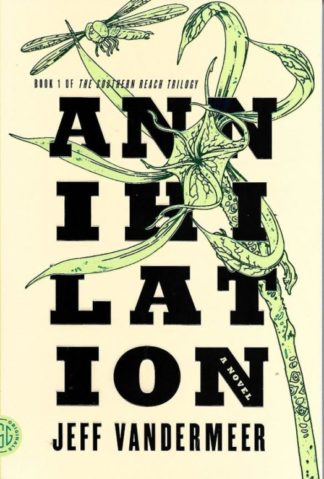 ANNIHILATION (FSG) was the first volume of JEFF VANDERMEER’S “Southern Reach” trilogy. It’s marked by an overpowering air of hallucinatory mystery, complimented by a page-turning narrative drive. Inspired, evidently, by Boris and Arkady Strugatsky’s ROADSIDE PICNIC (and/or the Andrei Tarkovsky helmed film adaptation STALKER), ANNIHILATION posits the existence of a mysterious tropical region known as Area X, which is closed off to human habitation by a government agency known as the Southern Reach. Eleven Southern Reach appointed scientific expeditions have been made into Area X, and all have ended in disaster.
ANNIHILATION (FSG) was the first volume of JEFF VANDERMEER’S “Southern Reach” trilogy. It’s marked by an overpowering air of hallucinatory mystery, complimented by a page-turning narrative drive. Inspired, evidently, by Boris and Arkady Strugatsky’s ROADSIDE PICNIC (and/or the Andrei Tarkovsky helmed film adaptation STALKER), ANNIHILATION posits the existence of a mysterious tropical region known as Area X, which is closed off to human habitation by a government agency known as the Southern Reach. Eleven Southern Reach appointed scientific expeditions have been made into Area X, and all have ended in disaster.
The story is told in the form of diary entries by “the Biologist,” one of four women making up the twelfth expedition. Judiciously placed flashbacks reveal that the Biologist’s husband had accompanied the previous expedition as a medic, allowing her a first-hand glimpse of the changes wrought by Area X—which included amnesia and cancer, from which the Biologist’s husband, and every other member of the eleventh expedition, eventually died.
The Biologist makes for an extremely well-rounded protagonist, harboring an overpowering obsession with biological life forms and a rather wily personality, two qualities that prove advantageous on her journey. The epic finale explains a fraction of the tantalizing mystery suffusing the nature and origins of Area X, with the greater portion of that mystery left to be explained (one hopes) in the Southern Reach Trilogy’s subsequent volumes.
The anthology DARK SCREAMS VOLUME ONE, edited by BRIAN JAMES FREEMAN and RICHARD 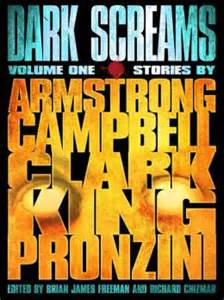 CHIZMAR (and published by Hydra), is kicked off by Stephen King’s magnificently unnerving “Weeds.” Loosely inspired by H.P. Lovecraft’s “Colour Out of Space,” it focuses on a backwoods hick undergoing macabre changes after a meteor crashes near his home. As the title promises, those changes involve unearthly weeds, which are spread by water. Next is “The Price You Pay” by Kelley Armstrong, a so-so exercise in upscale sadism. The impressive “Magic Eyes,” by the veteran mystery scribe Bill Pronzini, takes the form of a recollection by a psychopath who attempts to convince us that demonic forces are responsible for his murderous behavior. “Murder in Chains” by Simon Clark concerns a photographer who awakens to find himself attached to a lunatic via linked collars; how the photographer deals with this predicament, which comes to involve several other chained-up prisoners, makes for gripping (if distractingly SAW-like) reading. Lastly there’s “The Watched” by Ramsey Campbell, a powerfully atmospheric account of nightmarish apprehension that’s fully up to Campbell’s usual high standards.
CHIZMAR (and published by Hydra), is kicked off by Stephen King’s magnificently unnerving “Weeds.” Loosely inspired by H.P. Lovecraft’s “Colour Out of Space,” it focuses on a backwoods hick undergoing macabre changes after a meteor crashes near his home. As the title promises, those changes involve unearthly weeds, which are spread by water. Next is “The Price You Pay” by Kelley Armstrong, a so-so exercise in upscale sadism. The impressive “Magic Eyes,” by the veteran mystery scribe Bill Pronzini, takes the form of a recollection by a psychopath who attempts to convince us that demonic forces are responsible for his murderous behavior. “Murder in Chains” by Simon Clark concerns a photographer who awakens to find himself attached to a lunatic via linked collars; how the photographer deals with this predicament, which comes to involve several other chained-up prisoners, makes for gripping (if distractingly SAW-like) reading. Lastly there’s “The Watched” by Ramsey Campbell, a powerfully atmospheric account of nightmarish apprehension that’s fully up to Campbell’s usual high standards.
Final verdict: an effective anthology with two standout entries (the King and Campbell offerings) that by themselves are well worth the $2.99 asking price. Plus, at 73 pages nobody can say it’s too long.
Dark-Hued Historical Sagas
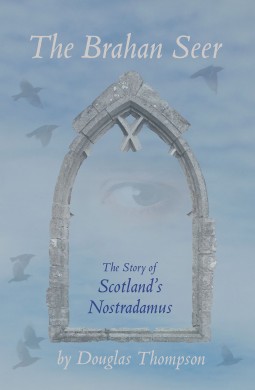 THE BRAHAN SEER by DOUGLAS THOMPSON (Acair) is an assured and compelling fictional account of Coinneach Odhar, a 17th Century Scottish man who allegedly possessed telekinetic powers. Thompson relates Odhar’s tale in a highly poetic manner that emphasizes the burnished landscapes, suggesting that Coinneach’s story is forever etched in the rocks, soil and sea of Scotland.
THE BRAHAN SEER by DOUGLAS THOMPSON (Acair) is an assured and compelling fictional account of Coinneach Odhar, a 17th Century Scottish man who allegedly possessed telekinetic powers. Thompson relates Odhar’s tale in a highly poetic manner that emphasizes the burnished landscapes, suggesting that Coinneach’s story is forever etched in the rocks, soil and sea of Scotland.
The novel begins with an old mystic who rapes Coinneach’s mother the day after her wedding. The mystic is killed but his powers live on in Coinneach, who as a child is visited by spectral friends that (in the manner of THE SHINING’S Tony) impart bits of pertinent information about the people around him. Coinneach grows into a unerringly virtuous man whose “talents” gain him widespread fame and important political connections. This leads to trouble, alas, when Coinneach reveals some better-left-unsaid information, and his story increasingly comes to resemble that of a certain other, much older supernaturally-endowed individual who was sacrificed for his convictions.
In an afterward the author makes it clear that his account, historically based though it may be, is comprised as much of legend as it is historical fact. Nonetheless, I can’t imagine a better fictional treatment of this enigmatic figure, in a book that works as good historical fiction and good fiction, period.
An ever darker historical saga arrived in the form of EAT HIM IF YOU LIKE by JEAN TEULE (Gallic 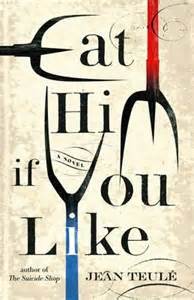 Books), a novelized account of the “Affaire de Hautefaye” that occurred on August 16, 1870. On that day Alain de Moneys, a kind-hearted young nobleman, set out to attend a fair in the French village Hautefaye, promising his mother he’d “just go there, say hello to a few people and come straight back.”
Books), a novelized account of the “Affaire de Hautefaye” that occurred on August 16, 1870. On that day Alain de Moneys, a kind-hearted young nobleman, set out to attend a fair in the French village Hautefaye, promising his mother he’d “just go there, say hello to a few people and come straight back.”
Alain’s ordeal begins shortly after he reaches the fair. Morale was extremely low at the time due to a severe drought and setbacks by France in the Franco-Prussian war, so when Alain is misheard making a perceived unpatriotic comment he becomes the unwitting focal point of the drunken crowd’s frustration. This results in a flurry of shouts and beatings that quickly give way to systematic torture that spans the length of Hautefaye.
Jean Teule spares the reader nothing in this pitiless account, and renders it in admirably lean fashion that sticks to the events of the Hautefaye Affair and its aftermath (in which four of Alain’s tormentors were guillotined) while keeping the background information (such as the particulars of the then-raging Franco-Prussian War) to a minimum. This results in a short (112 page) book that nonetheless packs a sizeable punch.
Long-in-Coming Translations
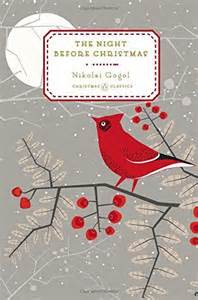 It’s taken nearly 200 years, but we finally have a good English translation, courtesy of Penguin, of THE NIGHT BEFORE CHRISTMAS, a demented Yuletide classic by Russia’s legendary NIKOLAI GOGOL. Picturesque and often downright bizarre, it has some of the madcap surrealism of Mikhail Bulgakov’s MASTER AND MARGARITA, with which it shares a pivotal character: the devil.
It’s taken nearly 200 years, but we finally have a good English translation, courtesy of Penguin, of THE NIGHT BEFORE CHRISTMAS, a demented Yuletide classic by Russia’s legendary NIKOLAI GOGOL. Picturesque and often downright bizarre, it has some of the madcap surrealism of Mikhail Bulgakov’s MASTER AND MARGARITA, with which it shares a pivotal character: the devil.
Here the big D appears one Christmas Eve in the sky above a Ukrainian village and steals the moon. He’s looking to get revenge on Vakula, a local blacksmith and sometime artist who’s become famous for a painting that depicts the devil in an unflattering light. Without the light of the moon Vakula has a difficult time finding his way around the village, which of course is part and parcel of the devil’s dastardly plans.
The major problem with this uproarious account for us westerners—and the probable reason it’s taken so long to be translated into English—is the simple fact that’s it’s so thoroughly Russian-centric, steeped in customs and language that will seem alien to non-Russians. As with quite a few of Gogol’s tales, one of the foremost joys of THE NIGHT BEFORE CHRISTMAS is its charming and erudite presentation of Ukrainian folklore, which conversely happens to also be its major stumbling point.
THE MYSTERIOUS DOCTOR CORNELIUS 1 by GUSTAVE LE ROUGE was the first of Black Coat 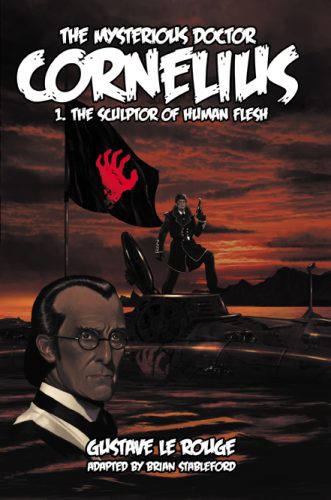 Press’s English language versions of the MYSTERIOUS DOCTOR CORNELIUS tales that thrilled France back in 2012, about the exploits of a demented surgeon who runs a criminal organization called the Red Hand. According to translator Brian Stableford’s introduction, Le Rouge essentially invented the concept of organized crime in these pages, which gives this pulpy tale a definite historical resonance.
Press’s English language versions of the MYSTERIOUS DOCTOR CORNELIUS tales that thrilled France back in 2012, about the exploits of a demented surgeon who runs a criminal organization called the Red Hand. According to translator Brian Stableford’s introduction, Le Rouge essentially invented the concept of organized crime in these pages, which gives this pulpy tale a definite historical resonance.
The main characters are the philanthropic millionaire Fred Jorgell and his evil son Baruch, who gets in trouble with the law in his native New York City. Cornelius surgically alters Baruch’s face, giving him the likeness of another virtuous millionaire, one Joe Dorgan—whose own face is changed to resemble that of Baruch, which lands Dorgan in an insane asylum while Baruch goes about his nefarious business in concert with the Red Hand.
Those looking for in-depth character development won’t find it here, as this account is pure narrative with nothing standing in the way of the storytelling momentum. It’s a bit crude in its construction, as is the case with much early 20th Century pulp fiction—an effect enhanced by an abundance of typos—but as pulpy escapism it works quite well.
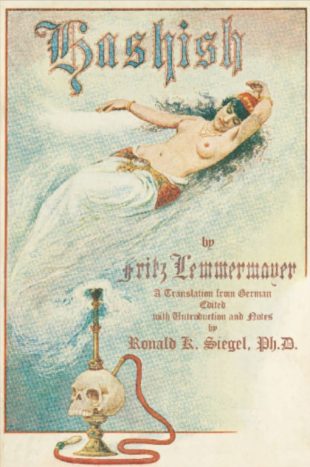 HASHISH: THE LOST LEGEND is a 19th Century German relic by FRITZ LEMMERMAYER, rescued from obscurity and translated into English by Ronald K. Siegel. It’s not quite the timeless masterpiece Siegel makes it out to be in his introduction, but HASHISH is certainly a strange and fascinating concoction that combines elements from ARABIAN NIGHTS with the iconic drug literature of the era.
HASHISH: THE LOST LEGEND is a 19th Century German relic by FRITZ LEMMERMAYER, rescued from obscurity and translated into English by Ronald K. Siegel. It’s not quite the timeless masterpiece Siegel makes it out to be in his introduction, but HASHISH is certainly a strange and fascinating concoction that combines elements from ARABIAN NIGHTS with the iconic drug literature of the era.
Allegedly based on an Oriental legend, HASHISH is set in Algeria, where the pure-hearted Ali is in love with the luscious Zuleyka. Zuleyka is stolen away by the wealthy slimeball Rustan, leaving Ali understandably dispirited. He’s approached by a shady personage who introduces himself as Yusuf, and turns Ali on to the joys of smoking hashish. Under its influence Ali finds “the things of reality mingled with the phantoms of his dreams. The nebulous structures took on tangible shapes and forms, the boundaries between being and seeming had vanished.” He goes on to fight—and win—a number of fierce battles under the ever-present eye of Yusuf, winding up as nothing less than the “lord of the world.”
The eventual twist isn’t exactly difficult to foresee, and nor is it any big trick figuring out Yusuf’s true identity, but one element I will unreservedly praise is the design by Process Media. The gorgeous cover art of the inaugural 1898 edition of HASHISH has been retained, as have the original black and white illustrations by G. Sieben, which are eye-popping, and nearly justify the book’s (admittedly highly inflated) price tag.
Two by Cortazar
Argentina’s JULIO CORTAZAR, to be exact, the late novelist whose story HEADACHE was initially 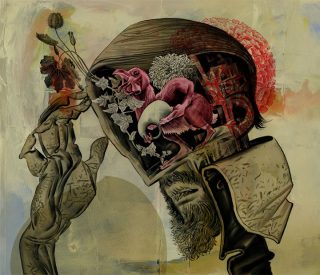 published in 1956, and made its English language debut via a nifty 17-page translation by Michael Cisco (and Tor.com). Deeply hallucinatory in nature, it concerns a man tasked with taking care of a cadre of bizarre creatures, an arduous, labor-intensive process made all the more difficult because the things exert a hallucinatory agent whose side effects include vertigo and insomnia. It all adds up to a powerfully haunting, dreamlike account that fully showcases Cortazar’s considerable talents.
published in 1956, and made its English language debut via a nifty 17-page translation by Michael Cisco (and Tor.com). Deeply hallucinatory in nature, it concerns a man tasked with taking care of a cadre of bizarre creatures, an arduous, labor-intensive process made all the more difficult because the things exert a hallucinatory agent whose side effects include vertigo and insomnia. It all adds up to a powerfully haunting, dreamlike account that fully showcases Cortazar’s considerable talents.
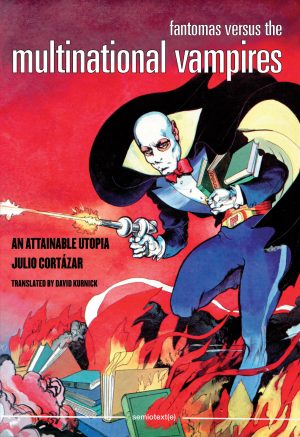 The same, unfortunately, cannot be said for FANTOMAS VERSUS THE MULTINATIONAL VAMPIRES: AN ATTAINABLE UTOPIA (Semiotext(e)), another long-in-coming Cortazar translation, this one of an eccentric political screed initially published in 1975. There’s a story of sorts, related in excessively pulpy and melodramatic fashion, about a man on a train reading a Mexican comic—the pages of which are reproduced here—about the legendary French figure Fantomas taking on the American-backed despoilers of 1970s-era South America.
The same, unfortunately, cannot be said for FANTOMAS VERSUS THE MULTINATIONAL VAMPIRES: AN ATTAINABLE UTOPIA (Semiotext(e)), another long-in-coming Cortazar translation, this one of an eccentric political screed initially published in 1975. There’s a story of sorts, related in excessively pulpy and melodramatic fashion, about a man on a train reading a Mexican comic—the pages of which are reproduced here—about the legendary French figure Fantomas taking on the American-backed despoilers of 1970s-era South America.
The comic pages, FYI, were taken from an actual funny book, of interest to Cortazar because he’s one of the main characters, along with Susan Sontag, Alberto Moravia and Octavio Paz. Another concern of Cortazar’s is the Second Russell Tribunal, which investigated the political strife in South America, and whose finding are reproduced here in a detailed appendix. Such real-life intrusions have the effect of reducing the rest of the book, rendering all the nonsense about the guy on the train as just that.
Three by Ligotti
Until 2014 THE AGONIZING RESURRECTION OF VICTOR FRANKENSTEIN AND OTHER GOTHIC TALES was among the scarcest books by the great THOMAS LIGOTTI. Kudos to Subterranean Press for finally making it available in affordable ebook 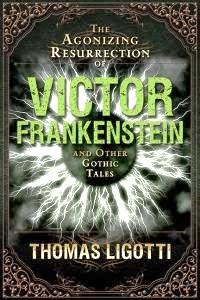 form.
form.
It’s one of Ligotti’s most atypical works, a short (50 page) collection of brief retellings of several iconic horror stories. The intent, as Ligotti makes clear in his introduction, was to increase the unpleasantness of such tales via newly conceived endings in which each account is “pushed onward in the direction of its unique and perverse apotheosis of pain.” In this respect we have the title story, in which Victor Frankenstein finds himself doomed to suffer the same agonies as the monster he created. “One Thousand Painful Variations Performed Upon Diverse Creatures Undergoing the Treatment of Dr Moreau, Humanist” sees the not-so-good doctor subjecting an experimental subject to even greater tortures than those imagined by H.G. Wells. In “The Heart of Count Dracula, Descendant of Attila, Scourge of God” we learn about the torments suffered by Dracula after he’s staked, just as “The Intolerable Lesson of the Phantom of the Opera” relates what occurs after the Phantom breathes his last, and his gal pal comes to grips with the intolerable emptiness of her existence.
The tales are all related in Ligotti’s usual refined manner, albeit without the hallucinatory brilliance of his more representative stories. Still, the contents of THE AGONIZING RESURRECTION OF VICTOR FRANKENSTEIN aren’t without worth, offering thought-provoking and oft-witty twists on several horror standards.
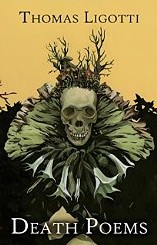 Another heretofore impossible-to-find Ligotti rarity was the 2004 poetry anthology DEATH POEMS, which turned back up in 2014 from Crossroad Press & Bad Moon Books. The subject, as the title makes clear, is death and its various properties, related in despairing stanzas like this one from “Closing Time”: “Things don’t last. When you’re gone you are gone and that is that,” as well as bleakly comedic offerings like this line from “Birthday”: “So just in case you’re not around next year: happy birthday.” Ligotti, in all frankness, isn’t as skilled with poetry as he is with prose, but DEATH POEMS succeeds in elegantly expressing its author’s anxiety about dying, which of course is something we all share.
Another heretofore impossible-to-find Ligotti rarity was the 2004 poetry anthology DEATH POEMS, which turned back up in 2014 from Crossroad Press & Bad Moon Books. The subject, as the title makes clear, is death and its various properties, related in despairing stanzas like this one from “Closing Time”: “Things don’t last. When you’re gone you are gone and that is that,” as well as bleakly comedic offerings like this line from “Birthday”: “So just in case you’re not around next year: happy birthday.” Ligotti, in all frankness, isn’t as skilled with poetry as he is with prose, but DEATH POEMS succeeds in elegantly expressing its author’s anxiety about dying, which of course is something we all share.
Finally there’s THE SPECTRAL LINK, a short (very short) 2-story collection from Subterranean Press. Inspired by a traumatic surgery Ligotti underwent in 2012, it’s very much in keeping with his career-long 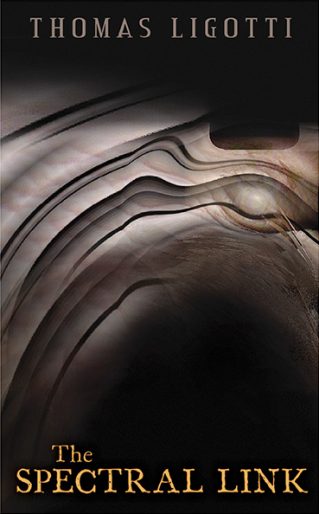 obsessions, with misanthropy and despair being the dominant emotions.
obsessions, with misanthropy and despair being the dominant emotions.
The mordant and hallucinatory “Metaphysica Morum” involves a medical procedure that, one assumes, is much like the one that inspired this book, as well as lucid dreaming and a spectral figure known as “The Dealer.” My only complaint is with the narrator-protagonist’s impossibly refined syntax; somehow I doubt a man who started life as the orphan child of inbred hicks, as this guy claims, would write things like “Those who contest demoralization as the inexorable way of universal deliverance have failed to see what is before them.”
THE SPECTRAL LINK’S second and last story is “The Small People,” whose narrator is horrified by a race of otherworldly beings whose reality, he believes, is gradually invading our own. Here Ligotti cleverly layers in a number of real-life issues, including bigotry and paranoia, while imparting a well-rounded story whose protagonist comes to suspect that the small people might be spreading their influence beyond their kind, and contaminating his own family line…
Reprints
 The two-volume UNUTTERABLE HORROR: A HISTORY OF SUPERNATURAL FICTION by S.T. JOSHI (HIPPOCAMPUS PRESS) was initially published in 2012, and has already attained iconic status. To be sure, its coverage of the genre is admirably exhaustive, and enhanced by highly erudite prose that offers sharp and unadorned judgments with a welcome absence of intellectual twaddle. Keep in mind, though, that S.T. Joshi is extremely opinionated, and that his tastes are often quite eccentric.
The two-volume UNUTTERABLE HORROR: A HISTORY OF SUPERNATURAL FICTION by S.T. JOSHI (HIPPOCAMPUS PRESS) was initially published in 2012, and has already attained iconic status. To be sure, its coverage of the genre is admirably exhaustive, and enhanced by highly erudite prose that offers sharp and unadorned judgments with a welcome absence of intellectual twaddle. Keep in mind, though, that S.T. Joshi is extremely opinionated, and that his tastes are often quite eccentric.
Volume one covers horrific literature from THE EPIC OF GILGAMESH, hailing from 1700 B.C.E., to the end of the 19th Century. THE CASTLE OF OTRANTO, the novel that kicked off the gothic fiction craze of the late 18th and early 19th centuries, is voluminously covered, as are MELMOTH THE WANDERER and the work of Edgar Allen Poe. Joshi dismisses acknowledged classics like A CHRISTMAS CAROL (“I fear the only way to salvage this work aesthetically is to assume that it is a parody”), THE STRANGE CASE OF DR. JEKYLL AND MR. HYDE, THE PICTURE OF DORIAN GRAY and even DRACULA, although he’s quite complimentary toward THE HOUSE OF THE SEVEN GABLES, THE TURN OF THE SCREW and the work of Ambrose Bierce.
Volume two covers the 20th and 21st Centuries, beginning with profiles of Arthur Machen, Algernon Blackwood, Lord Dunsay and M.R. James. Joshi’s affection for the fiction of these “Titans,” as well as that of Walter De La Mare, William Hope Hodgson, Franz Kafka and H.P. Lovecraft (to whom Joshi devotes an entire chapter), is fully evident. He’s also complimentary about the work of Fritz Leiber, William F. Nolan and Richard Matheson, but he chides THE HAUNTING OF HILL HOUSE for being “diffuse and unfocused,” while the fiction of Robert Aickman gets knocked for its obscurantism and Stephen King is written off as a “schlockmeister.” The one modern horror writer Joshi unequivocally praises is Ramsey Campbell, whose HOUSE ON NAZARETH HILL is proclaimed the definitive haunted house story. Thomas Tryon’s THE OTHER, David J. Schow’s THE SHAFT and Norman Partridge’s SLIPPIN’ INTO DARKNESS are also singled out for praise, but for the most part the news is quite bleak regarding today’s horror fiction.
Once again: taken as a two-part whole UNUTTERABLE HORROR is unquestionably one of the absolute best studies of its kind, but be prepared for some major disagreements!
TRIBESMEN by ADAM CESARE (Deadite Press), originally published in 2011, is a gore-packed tribute to 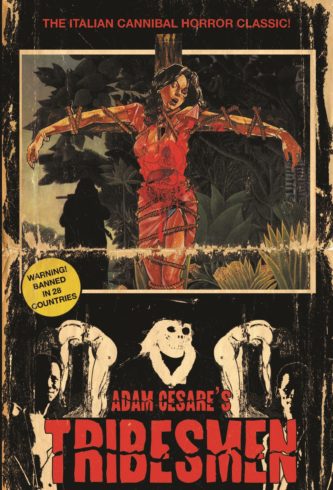 the cannibal film cycle of the 1970s and 80s. The characters include an exploitation movie producer who bankrolls a cannibal chomp-fest to be filmed in a Caribbean jungle, the universally hated anything-for-a-kick director of the opus, the non-English speaking star and the naive American-bred starlet.
the cannibal film cycle of the 1970s and 80s. The characters include an exploitation movie producer who bankrolls a cannibal chomp-fest to be filmed in a Caribbean jungle, the universally hated anything-for-a-kick director of the opus, the non-English speaking star and the naive American-bred starlet.
All are reasonably well developed personages, and the early-eighties exploitation milieu corresponds in most respects to what we know of the actual scene, which was marked by shameless cost-cutting and morally questionable acts. That latter factor becomes especially pressing when one of the principals, under the influence of some vaguely defined supernatural presence, goes mad, resulting in a bloody decapitation and a desperate chase through the jungle.
I’d question the addition of the supernatural, but otherwise this is a solid and crisply written account containing all the gore, perversion, movie in-jokes (Italian film buffs will note that many of the character names are taken directly from reality) and miscellaneous bad behavior any exploitation movie maven could possibly desire.
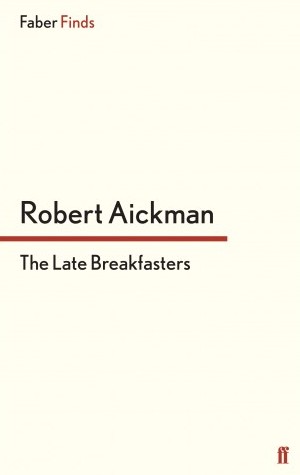 2014 also saw the long-awaited reprinting of the late ROBERT AICKMAN’S 1964 novel THE LATE BREAKFASTERS, courtesy of Faber. I’ll admit it wasn’t at all what I was expecting, being a mild-mannered yet impactful account of Griselda, a naïve young woman who enters into a “forbidden” lesbian affair, and in the process runs afoul of intolerant aristocrats during a visit to a stately manor—whose residents include a particularly restless ghost. From there poor Griselda is forced to come to terms with her thwarted love, and make her way in an unforgiving world.
2014 also saw the long-awaited reprinting of the late ROBERT AICKMAN’S 1964 novel THE LATE BREAKFASTERS, courtesy of Faber. I’ll admit it wasn’t at all what I was expecting, being a mild-mannered yet impactful account of Griselda, a naïve young woman who enters into a “forbidden” lesbian affair, and in the process runs afoul of intolerant aristocrats during a visit to a stately manor—whose residents include a particularly restless ghost. From there poor Griselda is forced to come to terms with her thwarted love, and make her way in an unforgiving world.
The supernatural intrusions, handled in a strikingly matter-of-fact manner, are but a minor aspect of this novel’s rich and evocative tapestry. It brings to life a vanished early-20th Century world in unforgettably vivid fashion, enlivened by Aickman’s wonderfully urbane prose.
Non-Fiction
THE DANCE OF REALITY (Park Street Press) is a positively mind-expanding memoir by everybody’s 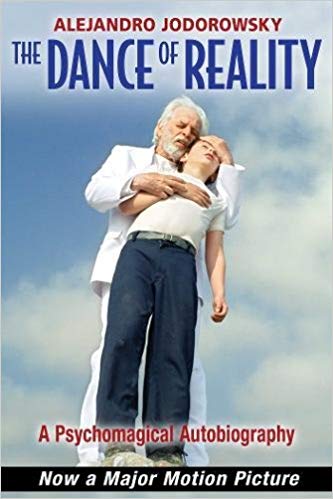 favorite Chilean madman ALEJANDRO JODOROWSKY, offering an uncensored glimpse into the endlessly fertile mind of one of the world’s most fascinating individuals.
favorite Chilean madman ALEJANDRO JODOROWSKY, offering an uncensored glimpse into the endlessly fertile mind of one of the world’s most fascinating individuals.
The book commences with Jodorowsky’s recollections of his 1940s-era childhood in a Chilean coastal village, marked by bullying and parental abuse. Jodorowsky rose above his problems, he claims, by rigorous meditation in which he learned to subside in an imaginative, poetic-based reality. This formed the basis of Jodorowsky’s controversial practice of “Psychomagic,” referring to therapy that utilizes the principles of surrealism.
Before Jodorowsky could perfect this practice, however, he became obsessed with pantomime art and decamped for Paris. There he fell in with Marcel Marceau and scripted several of Marceau’s most iconic routines. Also discussed are Jodorowsky’s encounters with various sorcerers and mystics, including the Zen master Ejo Takata, the South American alchemist Oscar Ichazo and the American author Carlos Castaneda.
Much of the book’s final hundred pages are devoted to describing the particulars of Psychomagic and its outgrowth, Psychoshamanism. Included are numerous case studies, such as one involving a singer who overcomes her lack of success by inserting a condom containing gold coins into her vagina during auditions, and another in which a woman who feels uncomfortable in her new house is encouraged to sprinkle drops of her urine around the residence. You might not buy into the reality of these claims, but this is a deeply fascinating book nonetheless.
 JOHN DUNNING was one of Canada’s premiere movie producers and exhibitors, responsible for the ILSA films, MY BLOODY VALENTINE and David Cronenberg’s early features SHIVERS and RABID. It’s no exaggeration to say that Dunning, together with his longtime partner Andre Link, was largely responsible for jump-starting Cronenberg’s career, along with those of many other Canadian cinema luminaries. YOU’RE NOT DEAD UNTIL YOU’RE FORGOTTEN (McGill-Queen’s University Press) consists of Dunning’s frank and witty memoir, followed by about fifty pages’ worth of testimonials about Dunning from Link, Cronenberg and many others.
JOHN DUNNING was one of Canada’s premiere movie producers and exhibitors, responsible for the ILSA films, MY BLOODY VALENTINE and David Cronenberg’s early features SHIVERS and RABID. It’s no exaggeration to say that Dunning, together with his longtime partner Andre Link, was largely responsible for jump-starting Cronenberg’s career, along with those of many other Canadian cinema luminaries. YOU’RE NOT DEAD UNTIL YOU’RE FORGOTTEN (McGill-Queen’s University Press) consists of Dunning’s frank and witty memoir, followed by about fifty pages’ worth of testimonials about Dunning from Link, Cronenberg and many others.
As related here, Dunning’s existence was one of constant and never-ending stress, beginning in his teens, when he managed his family-owned movie theater in Montreal’s Verdun. His early ventures into film production were as a distributor, purchasing French films for Montreal screens. It was around this time that Dunning came into contact with Andre Link, and Canada’s answer to Roger Corman was formed.
Dunning doesn’t go into the details of how his company Cinepix (which became CFP) was bought out by Lionsgate. This is covered fairly extensively in the Testimonials section, which also provides a good accounting of Dunning’s unerringly generous nature. As for the book overall, it stands as a vital testimony to a neglected slice of Canadian film history and one of its most unique players.
MRS. WAKEMAN VS. THE ANTICHRIST by ROBERT DAMON SCHNECK (Penguin) offers irrefutable 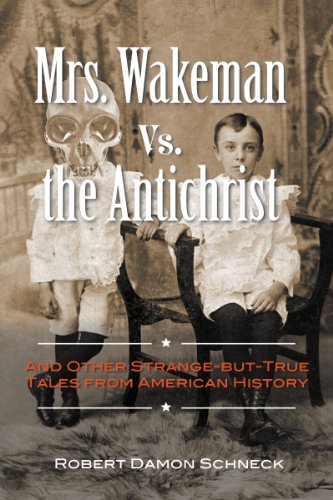 proof that truth really is stranger than fiction. It relates ten deeply strange and macabre true stories plucked from the darkest corners of American history.
proof that truth really is stranger than fiction. It relates ten deeply strange and macabre true stories plucked from the darkest corners of American history.
The account that gives the book its title pivots on the Connecticut based Rhoda Wakeman, who in the early 1800s came to believe she was God’s messenger; as such she ran a sect called the Wakemanites, whose devotion spiraled into homicidal madness. “The Four Wild Men of Dr. Dedge” relates the horrific experiments of Dr. Dedge, who created sideshow attractions by, among other things, inserting silver plates into men’s foreheads and attaching horns to them. Oddest of all is “The Man in Room 41 and Other Autodecapitants,” about James Moon, an inventor who one night in June of 1876 decapitated himself via an elaborate self-made machine.
Other chapters include “The Wee-Jee Fiends,” about the Ouija board panic that gripped America in the 1920s; “Bigfoot’s Gold: The Secret of Ape Canyon,” which examines a sasquatch sighting that includes UFOs and buried treasure; and “Ku Klux Clowns,” about the 20th Century clowns-in-vans scare.
It’s a good thing Robert Damon Schneck provides an extremely thorough set of notes and references, because otherwise I’d swear he was making at least some of this madness up. But apparently it’s all true, and laid out in extremely lively and reader-friendly fashion.
Recommended Non-Horror Releases
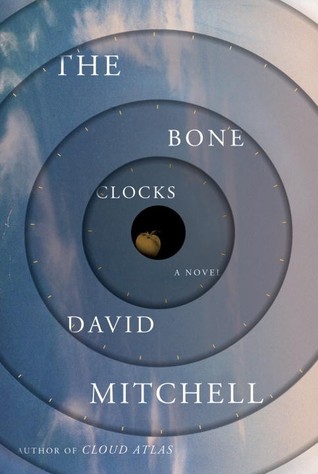 THE BONE CLOCKS By DAVID MITCHELL
THE BONE CLOCKS By DAVID MITCHELL
A highly intricate time travel-themed mind-roaster from Britain’s David Mitchell, who’s best known on these shores for the like-minded CLOUD ATLAS.
THE FIRST FIFTEEN LIVES OF HARRY AUGUST By CLAIRE NORTH
A gripping and eccentric sci fi-tinged thriller that reminded me of Ken Grimwood’s REPLAY (which if you haven’t already read you simply MUST do ASAP!).
MAD AS HELL By DAVE ITZKOFF
A thorough and enjoyable account of the making and reception of 1976’s still-pertinent media satire NETWORK, and also its late creator Paddy Chayefsky, apparently “the angriest man in movies.”
2013 Publications I Missed the First Time Around
THE RESURRECTIONIST (Quirk Books) is a wonderfully evocative bit of elegant grotesquerie that’s 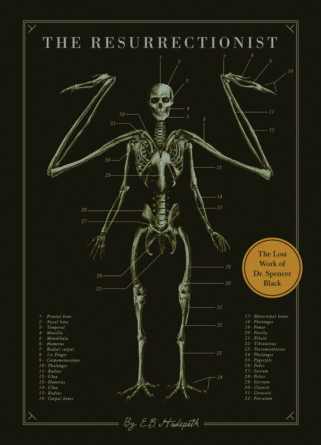 unique in every aspect. It was the first book by writer/illustrator E.B. HUDSPATH, who provides a two-part account that begins with a 65 page biography of a 19th Century figure named Dr. Spencer Black, apparently “one of the most remarkable physicians and scientific mavericks the world has ever known.”
unique in every aspect. It was the first book by writer/illustrator E.B. HUDSPATH, who provides a two-part account that begins with a 65 page biography of a 19th Century figure named Dr. Spencer Black, apparently “one of the most remarkable physicians and scientific mavericks the world has ever known.”
We learn how as a child the Boston-bred Dr. Black accompanied his surgeon father on grave robbing expeditions, the start of a lifelong obsession with death and transcendence. As he ages Black becomes determined to create living, breathing creatures, leading to a wealth of unholy experimentation. Writing-wise I’d have preferred a more descriptive account, although the evocative diary entries by Dr. Black and others nearly make up for the flatness of the prose.
Part two of THE RESURRECTIONIST is “The Codex Extinct Animalia,” consisting of Dr. Black’s anatomical studies of mythological creatures. Done in the style of an actual anatomical textbook complete with scientific commentary and detailed illustrations, this Codex makes for fascinating reading/viewing. Among the critters on display are the “Sphinx Alatus,” the “Ganesha Orientis” (an elephant-headed man with four arms boasting a “sinewy fiber woven through its bone structure”), the “Canis Hades,” the “Pegasus Gorganis” (the winged horse of Greek mythology), and so forth. THE RESURRECTIONSIST, I might add, is attractively packaged as a large format hardcover that’s sure to liven up any coffee table.
 From STEPHEN KING comes GUNS, an extended essay on gun control that was published in Kindle format by Audible Studios. In it King lays out his feelings about gun violence in America, adroitly shutting down the violent-media-made-them-do-it argument and laying out a three-step gun control program that’s sure to rile up many (and which King admits has little chance of ever coming to pass).
From STEPHEN KING comes GUNS, an extended essay on gun control that was published in Kindle format by Audible Studios. In it King lays out his feelings about gun violence in America, adroitly shutting down the violent-media-made-them-do-it argument and laying out a three-step gun control program that’s sure to rile up many (and which King admits has little chance of ever coming to pass).
King tries to take a bipartisan stance in the early pages, stating that “Every liberal in the country must watch Fox news for one year, and every conservative in the country must watch MSNBC for one year,” but his staunch left-of-center views ultimately win out in what stacks up as an appropriately troubling and provocative piece that can’t be said to really solve anything, but does give a perceptive voice to one side of this never-ending debate.
KEN RUSSELL’S DRACULA (Bear Claw Publishing) is a screenplay for a never-made film of DRACULA 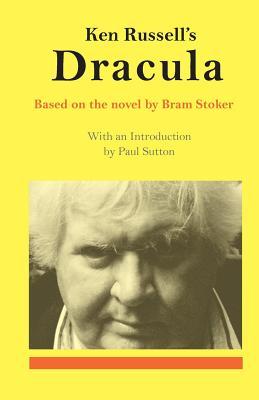 by England’s KEN RUSSELL, written in the late 1970s. According to a lengthy introduction by Russell biographer Paul Sutton, the movie was nearly made by Columbia, only to be abandoned when Universal put its Frank Langella headlined version of DRACULA into production.
by England’s KEN RUSSELL, written in the late 1970s. According to a lengthy introduction by Russell biographer Paul Sutton, the movie was nearly made by Columbia, only to be abandoned when Universal put its Frank Langella headlined version of DRACULA into production.
As a longtime Ken Russell fanatic I’d like very much to say this script is an unqualified triumph, and to be sure, it does contain some impressive things. Russell’s famously extroverted voice is evident in the opening pages, in which Jonathan Harker is attacked by a coachman-turned-werewolf. Harker’s sweetheart Lucy is rendered as an opera diva, and Dracula a personality-swapping aesthete. Russell’s revamped ending, meanwhile, is very likely the finest of any version of DRACULA, with the Count meeting his fate in a mythologically-inspired manner so perfect I’m amazed nobody else has utilized it.
However, the script as a whole is not the masterwork I was anticipating. It’s highly uneven and under-baked, with Dracula and Jonathan Harker having too little screen time and Dr. Seward, a minor character who treats Lucy, granted far too much. Even the copious hallucinatory episodes recognizable to any Russell fan are presented in annoyingly perfunctory fashion. I imagine these and other scenes would have been more properly fleshed out onscreen, which illuminates this script’s most glaring flaw: it’s status as an incomplete blueprint is all-too evident.
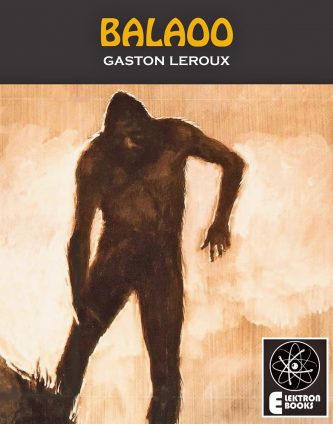 BALAOO (Elektron Ebooks), a 1911 novel by France’s GASTON LEROUX, is an altogether outrageous account of a pithecanthrope, or ape-man. Balaoo lives in an ornate tree-house, and is pressed into committing crimes by a band of forest-dwelling criminals, resulting in an accidental murder. But this pithecanthrope has a soft side, as evinced by his longing for Madeleine, the angelic daughter of the scientist who created Balaoo.
BALAOO (Elektron Ebooks), a 1911 novel by France’s GASTON LEROUX, is an altogether outrageous account of a pithecanthrope, or ape-man. Balaoo lives in an ornate tree-house, and is pressed into committing crimes by a band of forest-dwelling criminals, resulting in an accidental murder. But this pithecanthrope has a soft side, as evinced by his longing for Madeleine, the angelic daughter of the scientist who created Balaoo.
If any of this sounds familiar, that’s because the story is essentially a rehash of the same author’s PHANTOM OF THE OPERA, with a forest in place of an opera house. Yet it also foreshadows a certain 1930s-era film involving a dangerous but pure-hearted ape in love with a woman.
Those things, however, don’t change the fact that BALAOO is far from Leroux’s best work. It’s wildly disjointed, with a narrative that continually slips out of the author’s control. The racial implications of Balaoo’s existence are another problem, elucidated in a manner that appears uniformed at best, and outright racist at worst.
Where BALAOO excels is in Leroux’s oft-spectacular set-pieces, in which his penchant for the outrageous is given full reign. These include an unforgettable mid-book showdown between Balaoo and some overzealous lawmen that’s enlivened by the pithecanthrope’s ability to communicate with forest animals, who do his bidding in a brutal succession of captures and killings. Unfortunately, the climax is related for some unfathomable reason through a succession of mock newspaper clippings, which dilutes the suspense considerably and closes the novel out on an unexciting note.
1974’s THE TEXAS CHAINSAW MASSACRE is one of the seminal horror movies or our time. Its 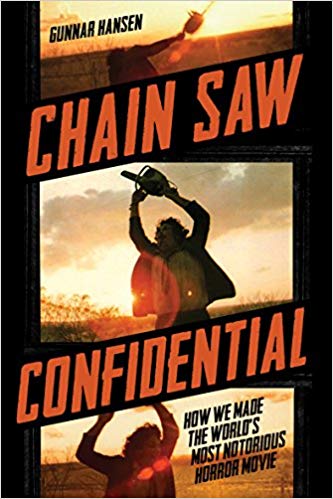 calamitous production has been widely documented, for which reason I’ll give CHAIN SAW CONFIDENTIAL (Chronicle Books), a lively account of the making and reception of TCM, a qualified recommendation: it’s certainly worth reading, but for TCM fans there probably won’t be a lot of information here you haven’t already heard.
calamitous production has been widely documented, for which reason I’ll give CHAIN SAW CONFIDENTIAL (Chronicle Books), a lively account of the making and reception of TCM, a qualified recommendation: it’s certainly worth reading, but for TCM fans there probably won’t be a lot of information here you haven’t already heard.
The author was GUNNAR HANSEN, who played the psychopathic Leatherface in TCM. Its four week shoot, as recollected by Hansen and his fellow cast and crewmembers—whose commentary is layered in with the author’s–was a nightmare, plagued by a painfully low budget and sweltering Texas heat that reached its apex during the infamous dinner table scene. Hanson also covers the finished film’s initially hostile reception and ultimate financial success. TCM’s participants, alas, didn’t share in that success due to shady distributors; as Hanson was bluntly informed, “It doesn’t matter how good the contract is…If they don’t want to pay you, they’re not going to pay you.”
The concluding chapters discuss the nature of horror media and how TCM fits in. TCM, Hansen argues, broke the rules that had governed horror films up until 1974; the ultimate irony, then, is that by today’s standards TCM is actually quite tame. The film’s unrelenting intensity and air of unfettered insanity, however, remain unsurpassed, and given the circumstances of TCM’s production it’s no wonder!
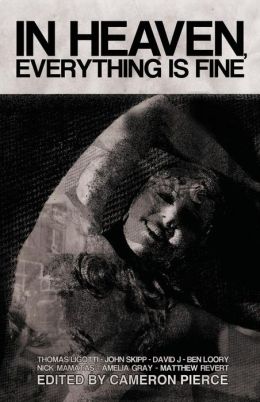 One anthology that seems tailor-made to my interests is the CAMERON PIERCE edited IN HEAVEN, EVERYTHING IS FINE (Eraserhead Press), consisting of stories inspired by the films of David Lynch. True, Lynch’s peculiar brand of nonlinearity works far better in filmic form than it does in prose, but any Lynch fan will surely get a kick out of the sublime oddness on display here.
One anthology that seems tailor-made to my interests is the CAMERON PIERCE edited IN HEAVEN, EVERYTHING IS FINE (Eraserhead Press), consisting of stories inspired by the films of David Lynch. True, Lynch’s peculiar brand of nonlinearity works far better in filmic form than it does in prose, but any Lynch fan will surely get a kick out of the sublime oddness on display here.
The contents include typically atypical offerings by several members of the Bizarro crew (Bradley Sands, Jeff Burk, Chris Kelso, Jeremy C. Shipp, Jeremy Robert Johnson), as well as Thomas Ligotti’s previously published “Teatro Grottesco” (whose cultivated syntax marks it out as something of an anomaly) and excursions in extreme weirdness by traditionally straightforward horrormeisters like Jeremy Thomas and John Skipp.
The tone is set by the opening story “Finding Yourself as Someone Else” by Matthew Revert, a nonlinear grab-bag of Lynchian motifs—an outwardly unassuming L.A. diner, seemingly innocuous pop tunes, identity crises—that recur through the remainder of the collection. The book also encompasses femme fatales, mannequins, elf men, the relentlessly esoteric wordplay of “Inland Where Secrets Lie” by Joseph S. Pulver Sr., and “A Model Made out of Card or, The Elephant Man and Other Reminiscences” by Gabriel Blackwell, which begins as a straightforward dissertation on THE ELEPHANT MAN and ends up as something else altogether. It’s also good to see the much-maligned LOST HIGHWAY, one of my favorite Lynch films, given some love in stories like Andrew Wayne Adams’s “Lou Reed Sings: This Magic Moment” and Simon Logan’s “Sextape.”
Weirdness for weirdness’s sake? Quite possibly, but for David Lynch buffs this collection is a goldmine.
Looking Forward
THE DEATH OF FANTOMAS by MARCEL ALLAIN, PIERRE SOUVESTRE
Black Coat Press has been announcing this, the premiere English translation of one of the pivotal volumes of France’s Fantomas series, for the last three or so years. Hopefully in 2015 they’ll finally get around to putting it out.
THE SCARLET GOSPELS by CLIVE BARKER
Another much-anticipated novel, a Clive Barker epic that features two of his most famous creations: HELLRAISER’S Pinhead and Harry D’Amour, the virtuous sleuth of THE LORD OF ILLUSIONS.
CINEMA ALCHEMIST By ROGER CHRISTIAN
Yet another publication that’s been on the drawing board for seemingly ever, a memoir by Roger Christian, who recounts his work as art director on STAR WARS and ALIEN, and as director of BLACK ANGEL.
ALBINA AND THE DOG MEN By ALEJANDRO JODOROWSKY
The premiere English-language translation of what is said to be an especially crazed novel by Jodorowsky.
THE BORDER By ROBERT McCAMMON
In which McCammon, whose recent output has been a bit uneven in my view, returns to the type of pulpy apocalyptic horror that marked 1987’s SWAN SONG (his finest work IMO) and 1988’s STINGER.
THE TOUCH By CLAIRE NORTH
An interesting-looking body-switching thriller from the talented author of THE FIRST FIFTEEN LIVES OF HARRY AUGUST.
